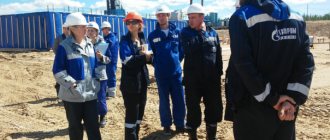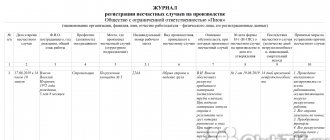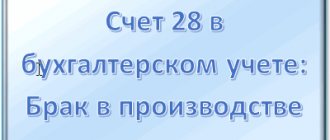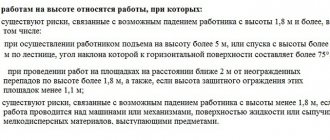Actions of the commission during the investigation
The main task of the commission or the person conducting the investigation (labor inspector) is to compare the accident with the production process. The investigation determines whether there is a connection between the incident and the production to which the employee is assigned.
To achieve this goal, the commission or labor inspector requests from the employer and the injured employee all available information that clarifies the connection between the production process and the accident or refutes such a connection. A written explanation with a detailed description of the event is taken from the injured person, and eyewitnesses of the accident are interviewed. IN
The official responsible for labor protection at work must be interviewed.
The commission inspects the place where the event that caused the accident occurred. The inspection process and results are recorded in the protocol. If necessary, the commission invites specialists from various fields to carry out verification activities and studies that are important for qualifying the incident.
For the purpose of the investigation, the commission requests and studies extracts from journals and accounting books, which indicate the conduct of briefings, the issuance of special clothing and footwear to employees, and protective equipment. Documents are requested confirming the elimination of deficiencies in the field of labor protection identified during previously conducted inspections. By decision of the commission, any other documents relevant for an objective and comprehensive investigation may be requested.
Qualification of an accident
The purpose of the investigation is to qualify the incident. The law defines a list of incidents that, upon investigation, can be classified as accidents not related to the production process, such events include:
- death due to illness, if there are medical studies and documents confirming that the disease is not occupational, death due to suicide;
- an accident that occurred due to the employee committing a crime;
- death or illness that occurs to an employee due to drug, alcohol or other poisoning, if this poisoning is not related to the performance of professional functions at work.
Events that occurred at work, or related to the professional activity of an employee, and resulted in damage to the employee’s health or death, are investigated and, if there is evidence, can be classified as industrial accidents.
An incident qualified by the commission as an accident that resulted in the death of a person, transfer of an employee to another job, or loss of ability to work is documented in a special document - an industrial accident report. If several people were injured in an accident, an act is created in relation to each injured person.
Definition of an accident
This is a traumatic injury to an employee’s health that occurred during the performance of actions performed on behalf of the employer or in any way related to lawful work activities.
Legal regulation
The interests of victims of an industrial accident are protected by the Federal Law of July 24, 1998 No. 125-FZ “On compulsory social insurance against industrial accidents and occupational diseases.” According to the provisions of Art. 227 of the Labor Code of the Russian Federation, it is necessary to investigate not only accidents that occurred with employees of the organization who signed an employment contract, but also with other persons involved in production.
In Art. 228 of the Labor Code of the Russian Federation describes the responsibilities that are assigned to the employer. The procedure for forming the composition of the commission investigating the incident is set out in Art. 229 Labor Code of the Russian Federation. After clarifying the circumstances for each accident, documentation is drawn up in accordance with Art. 230 Labor Code of the Russian Federation. If disagreements arise during the investigation, they are considered under Art. 231 Labor Code of the Russian Federation.
The rules for determining the degree of disability as a result of occupational diseases and accidents that occurred at work were approved by Decree of the Government of the Russian Federation of October 16, 2000 No. 789. Forms of papers that are required for recording and investigating accidents at work were approved by Decree of October 24 2002 No. 73 “On approval of the forms of documents required for the investigation and recording of industrial accidents.”
Classification
Accidents that occur in production are divided into several groups.
By number of victims:
- individual – 1 person was injured;
- group – the health of two or more people is damaged.
According to the severity of the consequences:
- microtraumas – health and ability to work are restored within 1 or several days;
- lungs – mild to moderate injuries have been sustained, but over time health is fully restored;
- severe - lead to disability;
- fatal - cause death.
Employer's responsibilities during an investigation
The employer immediately after learning of the accident creates a commission to investigate. It is headed by a representative of the employer. The employee affected by the incident has the right to participate in the investigation, give explanations and provide materials. The employer does not have the right to prevent the employee from participating in the investigation.
The employer is obliged to provide for the study of the commission at its request:
- diagrams, calculations, plans, documented research results, data received from specialists and experts in connection with the study of the circumstances and causes of the accident;
- photographic and video materials recording the place where the accident occurred;
- transport, premises for studying materials and conducting investigations, means of communication and personal protection.
The work and services necessary to obtain the listed information and ensure activities are paid for at the expense of the employer.
Responsibilities of the employer in the event of an accident
According to the Labor Code, the employer or his representative is obliged to:
- immediately organize first aid for the victim and, if necessary, transport him to a medical organization;
- take urgent measures to prevent the development of an emergency or other emergency situation and the impact of traumatic factors on other persons;
- until the investigation of the accident begins, preserve the situation as it was at the time of the incident, if this does not threaten the life and health of other persons and does not lead to a catastrophe, accident or other emergency circumstances, and if it is impossible to preserve it, record the current situation (draw up diagrams , take photographs or videos, and other events);
- immediately inform the authorities and organizations specified in this Code, other federal laws and other regulatory legal acts of the Russian Federation about the accident, and about a serious accident or fatal accident - also the relatives of the victim;
- take other necessary measures to organize and ensure a proper and timely investigation of the accident and registration of investigation materials in accordance with this chapter.
Any adequate employer is no less interested than the victim in ensuring that the accident investigation is carried out efficiently and in a timely manner, and in order to prevent such cases in the future, it is very important, based on the facts identified during the investigation:
- Identify and eliminate previously unaccounted for hazards that led to injury. For this purpose, new technical solutions are being applied, measures are being introduced to improve the quality of worker training in occupational safety, and unscheduled inspections of the condition of equipment and working conditions are organized.
Properly eliminating existing hazards will help prevent similar accidents.
- Determine whether the injury is related to the production process.
The Labor Code of the Russian Federation clearly defines situations in which NS is considered to be related to production.
An unscrupulous employee may try to pass off a domestic injury as an industrial injury, so it is very important for the employer to establish the true circumstances and causes of the incident.
- Understand why the work injury occurred: due to the fault of the employee, other persons, due to force majeure (for example, a hurricane, flood, earthquake), etc. It is important to know this in order to work correctly with employees who have committed violations: organize additional training, impose penalties, and assess compliance with the positions held.
- Correctly assign benefits and compensation related to work injuries.
The responsibilities of the head of the organization and the algorithm of actions in case of an accident are simplified and can be depicted in the form of a diagram:
Return to content
List of investigation materials
All data obtained during the investigation and relevant for classifying the accident as an industrial accident, or for disproving the connection of the incident with the production process, must be collected in full and properly documented.
Investigation materials include:
- regulatory document on the formation of a commission to conduct an investigation;
- photographs, video materials, technical documentation, diagrams and plans;
- accident scene inspection report;
- documentation about the state of the employee’s workplace, his suitability for work, the presence of harmful and dangerous factors in the production process;
- data from books and magazines of work briefings and materials confirming the testing of knowledge acquired by the employee during the briefing;
- explanations from persons who witnessed the accident, explanations from the victim and officials;
- medical documentation explaining the severity of the injuries received by the victim, or the cause of death;
- medical documents, certificates of examination of the victim for the presence of alcohol, toxic or other intoxication at the time of the incident;
- documents containing the results of research and work carried out during the investigation;
- conclusions of experts and specialists regarding the causes and conditions of the accident and identification of those responsible;
- documentation confirming that the employee has been provided with protective equipment, special clothing and footwear necessary for the safe performance of work activities in full;
- documents containing the results of safety inspections of workplaces and production processes carried out by authorized bodies. Documents confirming the elimination of deficiencies and compliance with the instructions of the inspection authorities.
The specified list of documents is not closed; if it is necessary to obtain additional information, the commission has the right to request the necessary data for an objective assessment of the circumstances of the accident and the identification of those responsible
Investigation of a minor industrial accident
A minor accident at work is a situation in which one employee of the enterprise is injured. And according to the order of the Ministry of Social Health Development No. 160, these injuries can be classified as minor.
In addition, this incident will be classified as minor if the employee is on sick leave for no more than 60 days and his ability to work after returning to work is reduced to 20%. But it is important to remember that the severity of the accident is assigned by the hospital.
The last mild case I had was this: the pombur was blowing out the manifold line and due to the residual pressure, which he did not release, the blowing device failed. The victim had the first phalanx of his left finger severed. There was a lot of blood. Colleagues were not at a loss, provided first aid and called an ambulance. Everyone was naturally scared.
Pombourg escaped with a slight fright, because the consequences could have been much worse. But no one wants to get even such an injury, neither the employee nor the employer.
Therefore, in the workplace, even when carrying out the simplest operation and manipulation, you need to be careful and remember that they are waiting for you at home safe and sound.
A mild accident is still not severe, but one way or another, you will need to work hard, and the period for investigating an accident with a mild outcome is much shorter, only three days.
Moreover, immediately after the investigation is completed, a set of measures must be taken to prevent such situations. And now we move into the thick of things.
Minor Accident Investigation Commission
The minor accident investigation commission is formed within the first 24 hours, and must be composed of at least three persons.
I repeat that the chairman of the commission is the employer or one of his deputies. Be sure to include a labor safety specialist, a trade union representative, or an employee representing the interests of workers, if you have one, as members of the investigation commission.
Important nuance! Do not include in the investigation commission employees who controlled the safety of the victim’s work, for example, the immediate supervisor.
They are not allowed to participate in the investigation so that they do not shield themselves, cannot influence the course of the investigation and do not contribute to the infringement of the rights of the victim.
During the investigation, the commission must inspect the scene of the incident:
- take photographs;
- record a video if necessary;
- draw up an inspection report.
For example, here’s a case from practice: during icy conditions, a janitor sprinkled sand on the area, but an engineer rushing for a smoke break chose to shorten his path and slip through the ice. He smoked after he was examined by a doctor.
Naturally, I slipped and bruised my knee joint. There were no cracks or fractures, but sick leave with code 04 was provided.
In this situation, the pedestrian paths with and without sand were immediately photographed so that the janitor could continue his work and protect other employees of the enterprise from injury.
Incident scene inspection protocol
Sample of filling out the inspection report of the accident scene of the NS
Sample of filling out the accident scene inspection report NS reverse side
The inspection report must indicate for what reasons the situation in the place where the incident occurred was not preserved or remained unchanged.
For example, as in my case, the situation was not preserved so as not to increase the risk of injury to other employees. This is what we indicate in the protocol. If it is possible to leave everything as it is until an investigation commission is formed and inspects the scene of the incident, then indicate this in the protocol - the situation at the scene of the incident has remained unchanged.
During the inspection, the presence of a special assessment of working conditions is revealed, and, accordingly, the presence of harmful and dangerous factors in the workplace; it analyzes the condition of the units, equipment, and tools that caused the injury. Whether special clothing and personal protective equipment were used at the time of injury, and much more.
If an injury occurs while using any equipment, then a report on its technical condition must be drawn up.
Definition of an insured event
In addition to investigating and qualifying the accident, it is necessary to find out whether the event is insurable or not. If an accident is recognized as insured, the insurer has obligations to the injured person - the employee is paid a sum of money.
During the investigation, the commission examines the circumstances of the incident.
As a result of the investigation, it may be revealed that the employee, due to his own gross negligence, suffered more serious injuries and injuries and thus aggravated the severity of the injuries. In this case, the commission establishes the degree of personal guilt of the employee, as a percentage. The degree of guilt is determined taking into account the opinion of the trade union organization.
Author of the article
NS classification
Time frames for investigating industrial accidents
There are NS without consequences, with consequences of moderate and increased severity. According to the number of incidents, there are single and group accidents. By the nature of the impact - mechanical, thermal, chemical and electrical.
Note! There is also a classification of industrial injuries by severity.
First degree of severity
Accidents with minimal consequences and microtraumas. These types of work accidents include abrasions, sprains, contusions, cuts, bruises and shallow wounds. They are characterized by the possibility of rapid human recovery (up to 14 days).
Second degree of severity
Emergency situations as a result of which an employee or a group of people received moderate injuries, for example, closed and open injuries to the phalanges of the fingers, arms and legs. Signs: there is no direct danger to life, no irreversible consequences for vital organs have been identified, loss of self-care ability is estimated from 10 to 30%.
Third degree of severity
Characterized by a direct danger to life. For example, such cases include injuries with blood loss of more than 20%, coma, shock, fracture of the skull and facial bones, intracranial trauma, embolism, serious injuries in the abdominal area, acute failure of vital organs.
Three degrees of severity of NS









